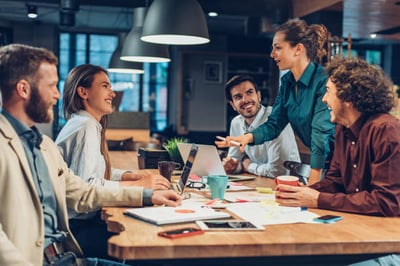
With a thriving job market, employees have the luxury of being choosy.
Offering good compensation is no longer enough to attract the best employees or to retain them. People want to feel passionate about their work, have access to cutting-edge technology, gain access to learning and development opportunities, and pave their own career path.
The sum of all these parts and everything in between is what makes up the overall employee experience. A subpar employee experience can have a ripple effect across the organization, shaping everything from how engaged people are to their enthusiasm for the company’s mission.
According to Gallup, only 32% of employees are actively engaged at work, meaning the vast majority of employees are not performing at their best because they are disengaged. Companies that seek employees who are already motivated and enthusiastic sometimes forget their end of the deal. To keep employees committed, you must invest in them.
If you're looking to overhaul your employee experience and reignite the spirit within your company culture, read on to learn five ways to get started!
Digital adoption within a company is seen as a competitive advantage to many modern job seekers. No one wants to show up on the first day at their dream job just to find out they’re not the forward-thinking company they signed up for. Without the right resources, doing any job becomes a massive headache.
Improving employee experience begins by giving your employees the right tools they need to do their job well. It’s a common misconception that incorporating more technology into your employee’s day will be a productivity vacuum. But in reality, investing in ways to alleviate the pain points of your employee’s workload communicates that they are a true priority.
In the same vein, forcing technology and software on your employees won’t be your ticket to success either. A study by Jamf surveyed 580 organizations across the globe and found a staggering correlation between allowing employees to choose what technology they use at work and their overall job satisfaction.
Sixty-eight percent of people stated they were more productive while 37% claimed to have improved creativity when given the choice to use their preferred device. Granting employees autonomy to pick which tools complement their working styles translates into more loyal, dedicated employees.
With changing work environments, employees want a stronger sense of control. In another study by PwC with over 12,000 participants, they found that 90% of leaders believe they are choosing tech options with their people in mind, but 53% of employees don’t see it that way. Employees feel that the technology and software being chosen for them isn’t done so knowledgeably. And we all know that when a person can’t do their job efficiently, the employee experience inevitably takes a nosedive.
|
TIP: To optimize your tech stack, it's important to have a tool like G2 Track that can help you manage the usage of tech software among your employees as well as the cost to your company overall. |
Trust is a central part of all human relationships. Without it in the workplace, it can be difficult to build a strong connection with your employees.
To understand the principles of trust, Professor Frances Frei gives an insightful TED Talk on what it is and how to build (or rebuild) it. Frei believes that when people learn to trust more, there will be unprecedented human progress because trust fuels productivity. Trust has three moving parts: authenticity, logic, and empathy. Each of these characteristics of trust must be intact in order for trust to be granted.
Imagine a work culture where the employees have little trust in their leaders. Do you think people are able to show up each day ready to work, passionate about their company? This trust is a vital aspect to the employee experience and can determine how productive your employees actually are.
It’s important to remember that trust is a two-way street. People expect managers to be honest in their feedback, strategic in their guidance, and true advocates for their employees. But while trust is often granted to higher-ups from the start, it’s sometimes unrequited to junior employees. By granting trust to your employees, you create space for growth and autonomy.
More companies are embracing trust as a gateway to autonomy. With this independence, employees grow more confident in their role, find fulfillment in that mastery, and eventually own projects that bring value to the company. In those organizations executives expect leadership to come from everywhere, not just the top.

Workplace learning and development (L&D) looks vastly different than it did 30 years ago. Instead of sitting through lengthy mandatory lectures, employees are actively seeking learning opportunities that support their individual learning styles and goals.
Making personal and professional development a priority in your company can directly impact productivity and retention. In LinkedIn’s 2019 Workplace Learning Report, they found that 82% of executives are championing employee engagement through professional development. L&D professionals are now proactively seeking skill gaps in various ways, such as conducting internal assessments and making room in meetings with senior executives.
As the progression of technology speeds up, new pathways for personal and professional development begin to take shape. Because of these opportunities, more money is allocated for online learning solutions. Nothing can fully replace the value of face-to-face learning, but no one can deny the benefits of online learning tools.
| Related: Read about edtech and how AI is impacting education technology in 2019! |
While it’s refreshing to know many employees are seeking ways to improve themselves, in an Udemy survey, 84% of U.S. workers still believe there is a skills gap among employees in the workplace. So giving the opportunity to upskill is necessary for two reasons: your company simply won’t keep up with its competitors and employees are demanding it.
Upskilling isn’t just the act of completing a new certification, it’s promoting a growth-mindset and creating the right behaviors to match. Allowing employees to take charge of their own learning path can give a new sense of confidence and autonomy, but it’s important for managers to provide guidance so they know where to focus their development. 
In your 1:1 meetings with your employees, ask them specific questions regarding their interest in learning and development. Knowing what drives your employees can provide you with an opportunity to connect on a personal and professional level.
| TIP: Have you considered implementing microlearning into your workplace? |
Career development has changed significantly over the years. There used to be a standard career path to follow: you put in the same amount of time and did the same type of work as those before you, climbing the proverbial career ladder. The modern employee no longer wants to wait years for a promotion, and they don’t have to.
The idea of working at one company for a lifetime is now unthinkable, and as the stigma of job-hopping has lessened, employees feel more comfortable doing it. A CareerBuilder survey noted that 45% of college grads will stay at a job fewer than two years, and by age 35, 25% of workers will have held five jobs or more. Valued employees who are dissatisfied with their career development can easily leave a company and land in a new job with a better salary.
So what can a company do to keep employees around?

As people managers, you have to recognize that your employees are making career assessments all the time. It’s your job to provide guidance on the development process with information, feedback, and continued motivation. Career paths are no longer static, so instead of focusing employees on attaining a specific role, help them grow their skills by giving the right kind of feedback.
In a recent study by The Predictive Index, data shows that employees actually enjoy feedback. Unfortunately, 44% of managers don't give enough. Don’t be afraid to share your insights with your employees if you feel it could be useful to them as they plan out their career path.
Managers can effectively drive employee engagement by helping to map out a personalized career plan. Planning short- and long-term growth plans shows your employees that the organization not only cares for them, but wants to see them excel.
| TIP: Read our comprehensive guide about creating a career path. |
Collaboration is mutually beneficial for every team member and has proven to be a huge catapult for success.
Before a company can focus on collaboration, it must look at how its employees communicate with one another. In a workplace, gossip and negative speech can disintegrate any trust or motivation that may have once existed.
The only way to combat this type of work environment is to learn how to communicate honestly and with tactful feedback. Relationships can determine the quality of our day-to-day lives, and allowing for honest feedback and open communication will strengthen the quality of these connections. It’s through these relationships built on trust that the groundwork for collaboration can be set.

In a global survey conducted by Slack, they found that good collaboration is simply the ease of communication. Most companies struggle with unclear communication; making joint cooperation toward a common goal impossible. In a negative environment, it’s unlikely that this problem will be solved no matter how many seminars employees sit through.
|
TIP: Slack is a great example of collaboration and productivity tool that helps teams collaborate at a high level. Do you use it for your workplace? |
Making the shift into a more enjoyable and productive workspace requires a collective effort from your team members and a sense of psychological safety. Psychological safety is the foundation of strong professional relationships and is the belief that your environment is safe for interpersonal risk taking. When teams feel comfortable enough to be vulnerable with their teammates and communicate openly, collaboration becomes organic.
When it comes down to it, people have the desire to collaborate, but often times they either don’t know how or don’t feel truly empowered. Managers, finding the solution begins with you. Have regular check-ins with you employees and find out what their challenges are, and if you see that working in silos is becoming a habit, work with them to break the cycle.
Without talented and dedicated people, a company won’t achieve what they set out to, no matter how great the idea. Businesses recognize that to stay competitive, they must find ways to bring out their employees’ best performance and create a culture that brings a strong sense of belonging and purpose.
The modern worker does not separate their work and personal life into two separate categories, and why would they when work consumes such a large portion? Giving your employees an opportunity to become their best selves and gain skills they can use in and out of the workplace are how companies achieve extraordinary success.
Interested in learning more? Read about unconscious bias and diversity in the workplace, two factors that help with improving employee experience.
Baili Bigham is a Junior Content Manager at 15Five, continuous performance management software that includes weekly check-ins, OKR tracking, peer recognition, 1:1s, and 360° reviews. When Baili isn’t writing, you can find her binge reading a new book or strategizing ways to pet every dog in San Francisco.
Are you confident your employees are satisfied at work?
.jpg) by Garret Stembridge
by Garret Stembridge
Employee onboarding looks different depending on what stage of the employee experience you’re...
 by Lauren Pope
by Lauren Pope
A good organization provides employment, but a great organization provides employee experience.
 by Neha Surana
by Neha Surana
Are you confident your employees are satisfied at work?
.jpg) by Garret Stembridge
by Garret Stembridge
Employee onboarding looks different depending on what stage of the employee experience you’re...
 by Lauren Pope
by Lauren Pope


